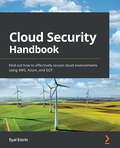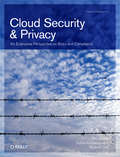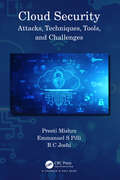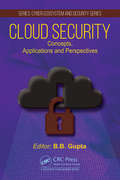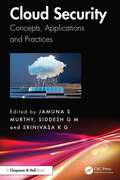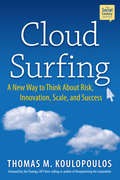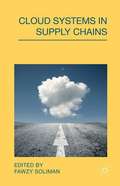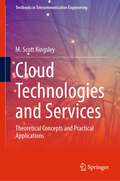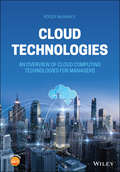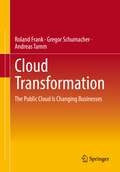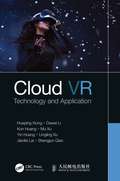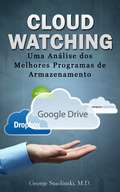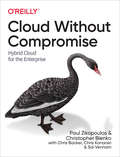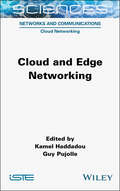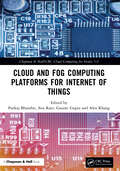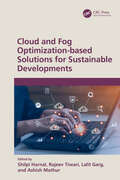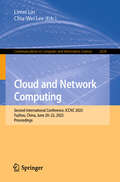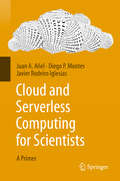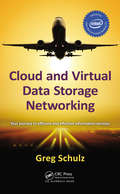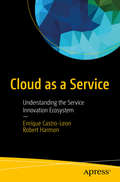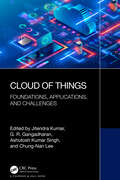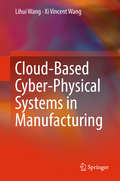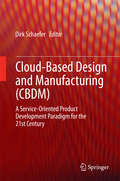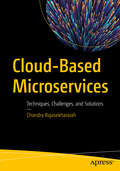- Table View
- List View
Cloud Security Handbook: Find out how to effectively secure cloud environments using AWS, Azure, and GCP
by Eyal EstrinA comprehensive reference guide to securing the basic building blocks of cloud services, with actual examples for leveraging Azure, AWS, and GCP built-in services and capabilitiesKey FeaturesDiscover practical techniques for implementing cloud securityLearn how to secure your data and core cloud infrastructure to suit your business needsImplement encryption, detect cloud threats and misconfiguration, and achieve compliance in the cloudBook DescriptionSecuring resources in the cloud is challenging, given that each provider has different mechanisms and processes. Cloud Security Handbook helps you to understand how to embed security best practices in each of the infrastructure building blocks that exist in public clouds.This book will enable information security and cloud engineers to recognize the risks involved in public cloud and find out how to implement security controls as they design, build, and maintain environments in the cloud. You'll begin by learning about the shared responsibility model, cloud service models, and cloud deployment models, before getting to grips with the fundamentals of compute, storage, networking, identity management, encryption, and more. Next, you'll explore common threats and discover how to stay in compliance in cloud environments. As you make progress, you'll implement security in small-scale cloud environments through to production-ready large-scale environments, including hybrid clouds and multi-cloud environments. This book not only focuses on cloud services in general, but it also provides actual examples for using AWS, Azure, and GCP built-in services and capabilities.By the end of this cloud security book, you'll have gained a solid understanding of how to implement security in cloud environments effectively.What you will learnSecure compute, storage, and networking services in the cloudGet to grips with identity management in the cloudAudit and monitor cloud services from a security point of viewIdentify common threats and implement encryption solutions in cloud servicesMaintain security and compliance in the cloudImplement security in hybrid and multi-cloud environmentsDesign and maintain security in a large-scale cloud environmentWho this book is forThis book is for IT or information security personnel taking their first steps in the public cloud or migrating existing environments to the cloud. Cloud engineers, cloud architects, or cloud security professionals maintaining production environments in the cloud will also benefit from this book. Prior experience of deploying virtual machines, using storage services, and networking will help you to get the most out of this book.
Cloud Security and Governance
by Sumner Blount Rob ZanellaThe rise of Cloud Computing, with services delivered in the cloudA", offers businesses incredible power and flexibility. It promises the efficient use of human and financial capital resources, reducing infrastructure and operation costs. It proposes a model of computing that is effective at meeting the demands of business in a rapidly changing environment. Security and Compliance Issues One of the most difficult challenges related to Cloud Computing, revolves around the security and compliance issues associated with it. This is a major concern and will continue to be so, with the ever increasing onslaught of regulations impacting security controls. This pocket guide explains and highlights some of the key security and compliance issues surrounding Cloud adoption, and provides helpful insight into how they can be addressed. Read this pocket guide and - Learn what Cloud Computing is - This guide provides a definition of Cloud Computing, before proceeding through essential characteristics that comprise it. Cloud deployment methods and the benefits of Cloud Computing are then discussed. Understand Cloud security and privacy issues - Security and compliance are two of the primary inhibitors in Cloud adoption. This pocket guide highlights the security and privacy considerations to keep in mind when planning your Cloud strategy. Be aware of the key compliance challenges - Cloud compliance has several important challenges that do not relate specifically to security. This guide details some of the key compliance challenges that you will need to address, including multinational considerations, business continuity and disaster recovery, legal issues and specific regulatory requirements. The areas of security and compliance often represent the biggest inhibitors to adoption of Cloud Computing, and because the potential impacts of problems in these areas are so profound, it is essential that you carefully identify your requirements in these areas, perform extensive due diligence, and work with your provider to develop and monitor processes that will help you both succeed. Ensure Successful Cloud Deployment - Buy this essential guide to Cloud Security and Compliance today!
Cloud Security and Privacy: An Enterprise Perspective on Risks and Compliance (Theory in Practice)
by Tim Mather Subra Kumaraswamy Shahed LatifYou may regard cloud computing as an ideal way for your company to control IT costs, but do you know how private and secure this service really is? Not many people do. With Cloud Security and Privacy, you'll learn what's at stake when you trust your data to the cloud, and what you can do to keep your virtual infrastructure and web applications secure. Ideal for IT staffers, information security and privacy practitioners, business managers, service providers, and investors alike, this book offers you sound advice from three well-known authorities in the tech security world. You'll learn detailed information on cloud computing security that-until now-has been sorely lacking.Review the current state of data security and storage in the cloud, including confidentiality, integrity, and availabilityLearn about the identity and access management (IAM) practice for authentication, authorization, and auditing of the users accessing cloud servicesDiscover which security management frameworks and standards are relevant for the cloudUnderstand the privacy aspects you need to consider in the cloud, including how they compare with traditional computing modelsLearn the importance of audit and compliance functions within the cloud, and the various standards and frameworks to considerExamine security delivered as a service-a different facet of cloud security
Cloud Security: Attacks, Techniques, Tools, and Challenges
by Preeti Mishra Emmanuel S Pilli R C JoshiCloud computing has gained paramount attention and most of the companies are adopting this new paradigm and gaining significant benefits. As number of applications and business operations are being facilitated by the cloud computing paradigm, it has become the potential target to attackers. The importance of well-organized architecture and security roles have become greater with the growing popularity. Cloud Security: Attacks, Techniques, Tools, and Challenges, provides an in-depth technical description about various key essential aspects of cloud security. We have endeavored to provide a technical foundation that will be practically useful not just for students and independent researchers but also for professional cloud security analysts for conducting security procedures, and all those who are curious in the field of cloud security The book offers comprehensive coverage of the most essential topics, including: Basic fundamentals of Cloud Computing Cloud security concepts, vulnerabilities, security standards and reference models Cloud security goals, key issues and privacy requirements Threat model, detailed taxonomy of cloud attacks, Attack feature analysis – case study A detailed taxonomy of IDS techniques and Cloud Intrusion Detection Systems (IDS) Attack and security tools, LibVMI – case study Advanced approaches: Virtual Machine Introspection (VMI) and Hypervisor Introspection (HVI) Container security: threat model, attacks and defense systems This book is intended for both academic and professional audience. It could also be used as a textbook, for a semester course at undergraduate and post graduate level in Computer Science, Information Technology, Information Security, and Information Science & Management. The book serves as basic reference volume for researchers in cloud security. It will be useful to practitioners, cloud security team, and the cloud security auditor as well. To get the most out of this book, the reader should have a working knowledge of various operating system environments, hypervisors, cloud computing fundamentals, programming languages like Python and a working knowledge of security tools.
Cloud Security: Concepts, Applications and Perspectives (Cyber Ecosystem and Security)
by Brij B GuptaCloud computing is an indispensable part of the modern Information and Communication Technology (ICT) systems. Cloud computing services have proven to be of significant importance, and promote quickly deployable and scalable IT solutions with reduced infrastructure costs. However, utilization of cloud also raises concerns such as security, privacy, latency, and governance, that keep it from turning into the predominant option for critical frameworks. As such, there is an urgent need to identify these concerns and to address them.Cloud Security: Concepts, Applications and Perspectives is a comprehensive work with substantial technical details for introducing the state-of-the-art research and development on various approaches for security and privacy of cloud services; novel attacks on cloud services; cloud forensics; novel defenses for cloud service attacks; and cloud security analysis. It discusses the present techniques and methodologies, and provides a wide range of examples and illustrations to effectively show the concepts, applications, and perspectives of security in cloud computing. This highly informative book will prepare readers to exercise better protection by understanding the motivation of attackers and to deal with them to mitigate the situation. In addition, it covers future research directions in the domain. This book is suitable for professionals in the field, researchers, students who are want to carry out research in the field of computer and cloud security, faculty members across universities, and software developers engaged in software development in the field.
Cloud Security: Concepts, Applications and Practices
by K. G. Srinivasa G. M. Siddesh Jamuna S. MurthyThis comprehensive work surveys the challenges, the best practices in the industry, and the latest developments and technologies. It covers the fundamentals of cloud computing, including deployment models, service models, and the benefits of cloud computing, followed by critical aspects of cloud security, including risk management, threat analysis, data protection, identity and access management, and compliance. Cloud Security explores the latest security technologies, such as encryption, multi‑factor authentication, and intrusion detection and prevention systems, and their roles in securing the cloud environment.Features: Introduces a user-centric measure of cyber security and provides a comparative study on different methodologies used for cyber security Offers real-world case studies and hands-on exercises to give a practical understanding of cloud security Includes the legal and ethical issues, including the impact of international regulations on cloud security Covers fully automated run-time security and vulnerability management Discusses related concepts to provide context, such as Cyber Crime, Password Authentication, Smart Phone Security with examples This book is aimed at postgraduate students, professionals, and academic researchers working in the fields of computer science and cloud computing.
Cloud Surfing: A New Way to Think About Risk, Innovation, Scale and Success
by Thomas M. KoulopoulosWhen people hear "the Cloud," they think of cloud computing and salesforce.com, just a sliver of what the Cloud is today. The Cloud has grown: it represents the consummate disruptor to structure; a pervasive social and economic network that will soon connect and define more of the world than any other political, social, or economic organization. The Cloud is the first megatrend of the twenty-first century, one that will shape the way we will address virtually every challenge we face for at least the next 100 years. It is where we will all live, work, and play in the coming decades. The Cloud is where your kids go to dive into online play. It's where you meet and make friends in social networks. It's where companies find the next big idea. It's where political campaigns are won and lost. Cloud Surfing is the groundbreaking book that will explain how to access the full value of the Cloud and how to embrace its possibilities.
Cloud Systems in Supply Chains
by Alan Brown Mark Thompson Jerry FishendenCloud Systems in Supply Chains explores the risks that could face supply chain firms if their implementation of cloud systems is not carefully managed or if not appropriately selected and supported. This volume aids supply chain firms in ensuring that their cloud system activities are positioned to assist and sustain their competitive advantages.
Cloud Technologies and Services: Theoretical Concepts and Practical Applications (Textbooks in Telecommunication Engineering)
by M. Scott KingsleyThis textbook provides a thorough yet compact review of cloud technologies. It offers easy to understand explanations of the technical concepts underlying cloud services, platforms, and applications offered by Amazon Web Services (AWS), Microsoft Azure, and the Google Cloud Platform (GCP). It presents cloud concepts at a depth that can be understood and applied by both technical and non-technical readers. Once that is accomplished the learner can then easily move toward more advanced topics. Or, they can use the knowledge gained from this book to obtain industry certifications and be competitive in this exciting industry. Reader learning is enhanced with quizzes and exam questions and hands-on labs throughout the book with PowerPoint slides, instructor guide and additional labs online. All the tools needed for advancement to the level of cloud architect are found in this book. The author has verified the success of this approach in his own academic environment with much success. He teaches Cloud Engineering and Advanced Cloud Engineering at Southern Methodist University. Both courses were developed in partnership with the AWS Academy, the education arm of the Amazon Web Services cloud platform. Using this methodology his students routinely take and pass cloud certification exams and obtain lucrative employment positions in the rapidly expanding cloud industry.
Cloud Technologies: An Overview of Cloud Computing Technologies for Managers
by Roger McHaneyContains a variety of cloud computing technologies and explores how the cloud can enhance business operations Cloud Technologies offers an accessible guide to cloud-based systems and clearly explains how these technologies have changed the way organizations approach and implement their computing infrastructure. The author—a noted expert on the topic—includes an overview of cloud computing and addresses business-related considerations such as service level agreements, elasticity, security, audits, and practical implementation issues. In addition, the book covers important topics such as automation, infrastructure as code, DevOps, orchestration, and edge computing. Cloud computing fundamentally changes the way organizations think about and implement IT infrastructure. Any manager without a firm grasp of basic cloud concepts is at a huge disadvantage in the modern world. Written for all levels of managers working in IT and other areas, the book explores cost savings and enhanced capabilities, as well as identifies different models for implementing cloud technologies and tackling cloud business concerns. This important book: Demonstrates a variety of cloud computing technologies and ways the cloud can enhance business operations Addresses data security concerns in cloud computing relevant to corporate data owners Shows ways the cloud can save money for a business Offers a companion website hosting PowerPoint slides Written for managers in the fields of business, IT and cloud computing, Cloud Technologies describes cloud computing concepts and related strategies and operations in accessible language.
Cloud Transformation: The Public Cloud Is Changing Businesses
by Roland Frank Gregor Schumacher Andreas TammIn this book you will learn how the public cloud is significantly changing the cost structures of digital business models and thus existing markets. The relationships between the cloud architectures used, the organization of the company and the price and business models that are possible as a result are shown clearly and so that they can be used in your own company. The authors explain how, one after the other, more and more markets are becoming digital markets and what role marginal costs play in this. They describe how cloud-based IT is disrupting classic IT. This enables small teams to build scalable business models worldwide at zero marginal costs with little investment. The economic effects are clearly illustrated using specific examples. In addition, technical laypeople get an overview of which factors are particularly important for the competitiveness of their digital business models and how managers can influence them. Finally, the book gives practitioners specific guidelines on how the cloud transformation can be carried out in their company. The book is aimed primarily at executives and employees in the specialist departments and IT who want to drive the cloud transformation in their companies. This book is a translation of the original German 1st edition, Cloud-Transformation by Roland Frank, Gregor Schumacher and Andreas Tamm published by Springer Fachmedien Wiesbaden GmbH, part of Springer Nature in 2019. The translation was done with the help of artificial intelligence (machine translation by the service DeepL.com). A subsequent human revision was done primarily in terms of content.
Cloud VR: Technology and Application
by Huaping Xiong Dawei Li Kun Huang Mu Xu Yin Huang Lingling Xu Jianfei Lai Shengjun QianBased on the technical accumulation and practice of Huawei iLab in the Cloud VR field, this book systematically describes the advantages of Cloud VR technologies; technical requirements on clouds, networks, and terminals as well as solution implementation; Cloud VR experience evaluation baselines and methods; and current business practices. Cloud VR introduces cloud computing and cloud rendering to VR services. With fast and stable networks, cloud-based display output and audio output are coded, compressed, and transmitted to user terminals, implementing cloud-based VR service content and content rendering. Cloud VR has stringent requirements on bandwidth and latency, making it a proficient application for 5G and gigabit home broadband networks in the era of "dual G". As the first advocate of Cloud VR, Huawei iLab developed the first prototype of the Cloud VR technical solution, initiated the industry’s first Cloud VR industry cooperation plan – VR OpenLab with partners – and incubated the world’s first Cloud VR commercial project with China Mobile Fujian. Cloud VR: Technology and Application is the first official publication of Huawei iLab’s research and practice achievements. It systematically and thoroughly introduces the Cloud VR concept, solution architecture, key technologies, and business practices and is of great value in academic and social applications. This book is easy to understand, practical, and suitable for VR vendors, VR technology enthusiasts, carriers, network vendors, cloud service providers, universities, and other enterprises and scientific research institutes.
Cloud Watching
by Hugo Martins George SmolinskiOrganizar e armazenar informações sempre foi uma precupação da humanidade desde os tempos antigos e continuará sendo, pois é inerente a natureza humana. Com o advento do Armazenamento Virtual, a forma como lidamos em manter tais informações seguras e organizadas mudou incrivelmente, tornando-se fundamental adaptar-se a esta nova era da tecnologia. E para entender e usar esta tecnologia é que, com grande satisfação, tive o prazer de colaborar na publicação, em português, do livro do Dr. George Smolinski. Sua simplicidade, e a sua efetividade, em elucidar as características e utilização dos principais serviços disponíveis atualmente, faz desta obra ter uma importância singular no meio de tantos outros materias disponíveis.
Cloud Without Compromise: Hybrid Cloud for the Enterprise
by Paul Zikopoulos Christopher Bienko Chris Backer Chris Konarski Sai VennamMany companies claim to have "gone to the cloud," yet returns from their efforts are meager or worse. Why? Because they've defined cloud as a destination, not a capability. Using cloud as a single-vendor, one-stop destination is fiction; in practice, today's organizations use a mosaic of capabilities across several vendors. Your cloud strategy needs to follow a hybrid multicloud model, one that delivers cloud's value at destinations you choose.This practical guide provides business leaders and C-level executives with guidance and insights across a wide range of cloud-related topics, such as distributed cloud, microservices, and other open source solutions for strengthening operations. You'll apply in-the-field best practices and lessons learned as you define your hybrid cloud strategy and drive your company's transformation strategy.Learn cloud fundamentals and patterns, including basic concepts and historyGet a framework for cloud acumen phases to value-plot your cloud futureKnow which questions to ask a cloud provider before you signDiscover potential pitfalls for everything from the true cost of a cloud solution to adopting open source the right way
Cloud and Edge Networking
by Guy Pujolle Kamel HaddadouA major transformation in the world of networks is underway, as the focus shifts from physical technology to software-based solutions. In this book, the authors present this new generation of networks that are based in the Cloud by detailing the transition from a complex environment to a simple digital infrastructure. This infrastructure brings together connected devices, the antennas that collect radio waves, the optical fibers that carry signals and the data center that handles all of the different processes. From this perspective, the data center becomes the brain, managing network services, controls, automation, intelligence, security and other applications. This architecture is relevant to carrier networks, the Internet of Things, enterprise networks and the global networks of the major Internet companies. Cloud and Edge Networking further discusses developments at the border of networks, the Edge, where data is processed as near as possible to the source. Over the next ten years, the Edge will become a major strategic factor.
Cloud and Fog Computing Platforms for Internet of Things (Chapman & Hall/CRC Cloud Computing for Society 5.0)
by Gaurav Gupta Alex Khang Pankaj Bhambri Sita RaniToday, relevant data are typically delivered to cloud-based servers for storing and analysis in order to extract key features and enable enhanced applications beyond the basic transmission of raw data and to realize the possibilities associated with the impending Internet of Things (IoT). To allow for quicker, more efficient, and expanded privacy-preserving services, a new trend called Fog Computing has emerged: moving these responsibilities to the network's edge. Traditional centralized cloud computing paradigms confront new problems posed by IoT application growth, including high latency, limited storage, and outages due to a lack of available resources. Fog Computing puts the cloud and IoT devices closer together to address these issues. Instead of sending IoT data to the cloud, the fog processes and stores it locally at IoT devices. Unlike the cloud, fog-based services have a faster reaction time and better quality overall. Fog Computing, Cloud Computing, and their connectivity with the IoT are discussed in this book, with an emphasis on the advantages and implementation issues. It also explores the various architectures and appropriate IoT applications. Fog Computing, Cloud Computing, and Internet of Things are being suggested as potential research directions. Features: A systematic overview of the state-of-the-art in Cloud Computing, Fog Computing, and Internet of Things Recent research results and some pointers to future advancements in architectures and methodologies Detailed examples from clinical studies using several different data sets
Cloud and Fog Optimization-based Solutions for Sustainable Developments
by Rajeev Tiwari Lalit Garg Shilpi Harnal Ashish MathurCloud and Fog Optimization-based Solutions for Sustainable Developments discusses the integration of fog computing and the Internet of Things to provide scalable, secure, and cost-effective digital infrastructures for smart services in diverse domains: Highlights resource management solutions for the Internet of Things devices in fog computing architectures Discusses waste management using cloud and fog computing for sustainable development, and optimization of the Internet of Things in fog computing for fault tolerance Covers smart surveillance and monitoring using cloud and fog computing, and energy-efficient smart healthcare Explains energy-efficient frameworks for cloud-fog environments for sustainable development, and smart grid infrastructure using cloud and fog computing Presents the management of metropolitan mobility for public transport and smart vehicles with cloud and fog computing The text is primarily written for senior undergraduates, graduate students, and academic researchers in the fields of electrical engineering, electronics and communications engineering, computer science and engineering, and information technology.
Cloud and Network Computing: Second International Conference, ICCNC 2025, Fuzhou, China, June 20–22, 2025, Proceedings (Communications in Computer and Information Science #2539)
by Chia-Wei Lee Limei LinThis book constitutes the proceedings of the Second International Conference on Cloud and Network Computing, ICCNC 2025, which was held in Fuzhou, China, during June 20–22, 2025. The 31 full papers presented in this volume were carefully reviewed and selected from 88 submissions. They are grouped into the following topics: Cloud & Edge Computing; Network Computing; Big Data Analysis and Artificial Intelligence; Security & Privacy.
Cloud and Serverless Computing for Scientists: A Primer
by Juan A. Añel Diego P. Montes Javier Rodeiro IglesiasThis book offers an introduction to cloud computing and serverless computing for students, researchers and R&D organizations through several practical examples. Rather than focusing exclusively on the computational issues related to cloud computing, the authors focus on addressing the multidisciplinary applications of cloud computing for daily research work in public institutions and private companies in fields such as archaeology, geosciences, computer sciences, medicine and physics. The book also discusses the emergence of serverless computing over the last three years as a means to make computational infrastructures more apparent to users, avoiding the need to concern one's self with the type of server or computing machine needed to perform a computing task. These topics are presented from the perspective of users, researchers and decision-makers, and are approached based on the authors' collective experience on the use and adoption of cloud computing.
Cloud and Virtual Data Storage Networking
by Greg SchulzThe amount of data being generated, processed, and stored has reached unprecedented levels. Even during the recent economic crisis, there has been no slow down or information recession. Instead, the need to process, move, and store data has only increased. Consequently, IT organizations are looking to do more with what they have while supporting gr
Cloud as a Service: Understanding the Service Innovation Ecosystem
by Enrique Castro-Leon Robert HarmonSee how the principles of Service Science govern the dynamics driving the adoption of cloud computing in the industry.Cloud as Service shows you how the evolution of enterprise computing platforms to application-specific cloud platforms (ASCPs) have aligned to business needs. You'll also learn processes for developing and building ASCPs. You'll gain insight into how executives, managers, and technologists are utilizing cloud services, cloud service providers, equipment manufacturers, and software and application vendors participating in cloud supply chains.For business, the appeal of cloud computing must go beyond the notion of convenient, on-demand access of networked pooled access to computing resources. Industry leaders have learned to apply cloud computing to become more nimble, cost effective, and customer engaging as they strive for competitive advantage, regardless of size. These companies define and build cloud platforms customized for their needs rather than using someone else’s. This book shows you how to use a holistic, end-to-end view of platform planning, platform development, supply chains and operations to collapse platform development times to a fraction of the original time. You’ll see that strategies for selling to the cloud market are essentially incomplete; and that in order to be successful, businesses must become cloud service businesses themselves, incorporating cloud technologies in their engineering, IT, sales and marketing, and delivery processes. What You'll Learn:Historical perspective to provide insight into the dynamics driving cloud evolution todayState of the art in IT requirements and cloud solutionsThe value of User Experience (UX) driven design principlesThe crucial roles of Service Brokers and Service Assurance ManagersThe landscape of emerging cloud services and what they mean to your enterpriseService Portals and Enterprise Service BusesWho This Book Is For:CIOs, CTOs, data center architects, solution architects and application engineers Educational institutions building a systems integration curriculum Developers who want to understand how their work fits in the cloud ecosystem
Cloud of Things: Foundations, Applications, and Challenges
by G. R. Gangadharan Jitendra Kumar Ashutosh Kumar Singh Chung-Nan LeeCloud computing is the on-demand availability of computer system resources, especially data storage and computing power, without direct active management by the user. This book explores algorithms, protocols, and system design principles of key smart technologies including cloud computing and the internet of things.• Discusses the system design principles in cloud computing along with artificial intelligence, machine learning, and data analytics applications• Presents blockchain-based solutions, cyber-physical system applications, and deep learning approaches to solving practical problems• Highlights important concepts including the cloud of things architecture, cloud service management and virtualization, and resource management techniques• Covers advanced technologies including fog computing, edge computing, and distributed intelligence• Explores cloud-enabling technology, broadband networks and internet architecture, internet service providers (ISPs), and connectionless packet switching.The book is primarily written for graduate students, academic researchers, and professionals in the field of computer science and engineering, electrical engineering, and information technology.
Cloud-Based Cyber-Physical Systems in Manufacturing
by Lihui Wang Xi Vincent WangThis book presents state-of-the-art research, challenges and solutions in the area of cloud-based cyber-physical systems (CPS) used in manufacturing. It provides a comprehensive review of the literature and an in-depth treatment of novel methodologies, algorithms and systems in the area of architecture design, cyber security, process planning, monitoring and control. The book features detailed descriptions of how to derive solutions in a cloud environment where physical machines can be supported by cyber decision systems when engaged in real operations. It presents a range of novel ideas and is characterized by a balanced approach in terms of scope vs. depth and theory vs. applications. It also takes into account the need to present intellectual challenges while appealing to a broad readership, including academic researchers, practicing engineers and managers, and graduate students. Dedicated to the topic of cloud-based CPS and its practical applications in manufacturing, this book benefits readers from all manufacturing sectors, from system design to lifecycle engineering and from process planning to machine control. It also helps readers to understand the present challenges and future research directions towards factories of the future, helping them to position themselves strategically for career development.
Cloud-Based Design and Manufacturing (CBDM): A Service-Oriented Product Development Paradigm for the 21st Century
by Dirk SchaeferThe book introduces the reader to game-changing ways of building and utilizing Internet-based services related to design and manufacture activities through the cloud. In a broader sense, CBDM refers to a new product realization model that enables collective open innovation and rapid product development with minimum costs through social networking and negotiation platforms between service providers and consumers. It is a type of parallel and distributed system consisting of a collection of inter-connected physical and virtualized service pools of design and manufacturing resources as well as intelligent search capabilities for design and manufacturing solutions. Practicing engineers and decision makers will learn how to strategically position their product development operations for success in a globalized interconnected world.
Cloud-Based Microservices: Techniques, Challenges, and Solutions
by Chandra RajasekharaiahUse this field guide as you transform your enterprise to combine cloud computing with a microservices architecture.The recent surge in the popularity of microservices in software development is mainly due to the agility it brings and its readiness for the cloud. The move to a microservices architecture on the cloud involves a gradual evolution in software development. Many enterprises are embarking on this journey, and are now looking for architects who are experienced in building microservices-based applications in the cloud. A master architect should be able to understand the business, identify growth hurdles, break a monolith, design microservices, foresee problems, overcome challenges, change processes, decipher CSP services, strategize cloudification, adopt innovations, secure microservices, prototype solutions, and envision the future. Cloud-Based Microservices provides you with the information you need to be successful in such an endeavor. What You Will Learn Be familiar with the challenges in microservices architecture and how to overcome themPlan for a cloud-based architectureArchitect, build, and deploy microservices in the cloudKnow how security, operations, and support change in this architecture Who This Book Is For Engineers, architects, and those in DevSecOps attempting to move their enterprise software to take advantage of microservices and the cloud and be more nimble
